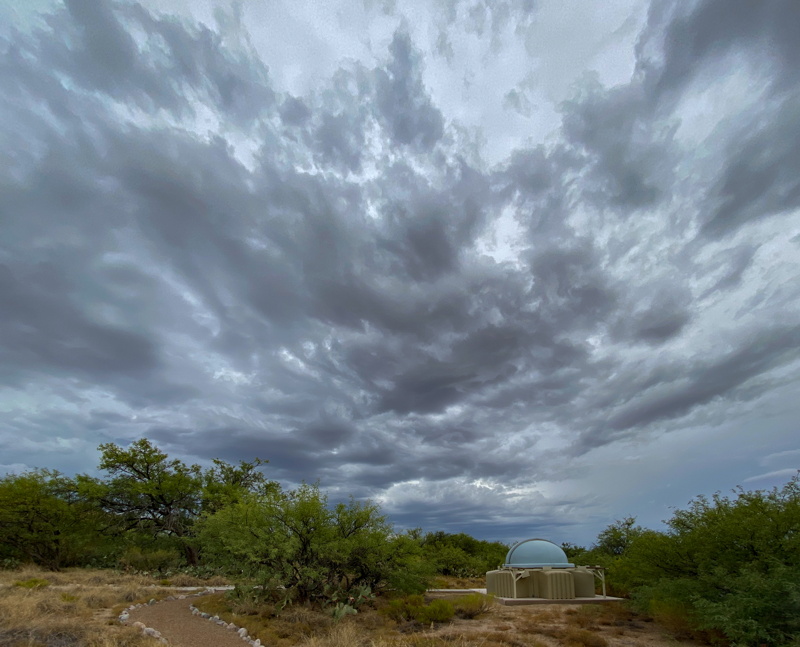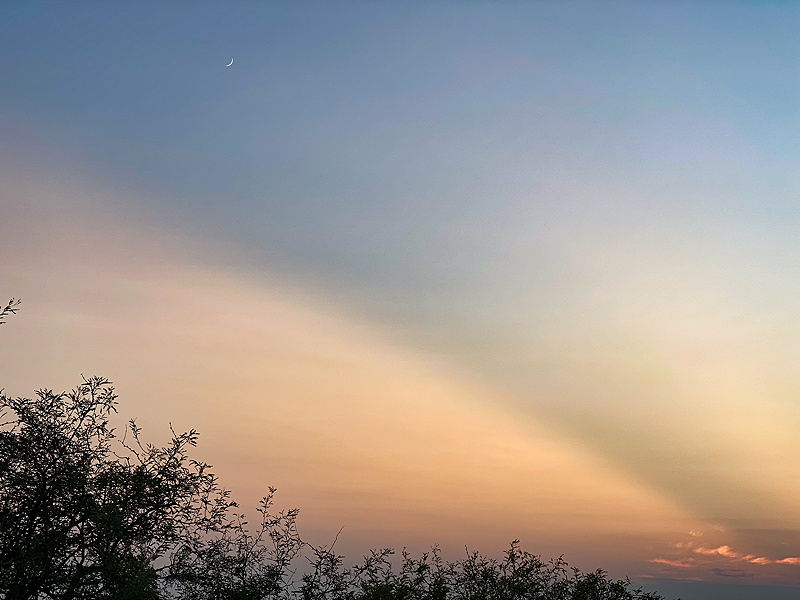Weather, Air Conditioner, Another Wildfire,
11th First Light Anniversary, iPhone Planets
Posted: 22 August 2020
Monday, 10 August 2020, was mostly clear until sunset approached when clouds began arriving. An hour before sunset on Tuesday, 11 August, the sky was overcast, wiping out my plans to observe and photograph the Perseid Meteor Shower that night.

Cloudy skies continued until Saturday, 15 August, when the sky was clear during the day. However, the sky began clouding up late afternoon as Monsoon storms began popping up in southeastern Arizona, resulting in this pretty view 40 minutes before sunset.

Sunday morning, 16 August, was mostly clear, but clouds began appearing early afternoon. By late afternoon the sky was mostly cloudy from thundershowers in the area with nearly continuous thunder heard. There was a brief thunderstorm here with some hard rain (0.2") and some pea-sized hail. A few miles south there was a report of 2" diameter hail! It was our first decent storm this Monsoon Season (or "nonsoon" as many locals are calling it).
Monday, 17 August, dawned mostly clear. The electrician was finally able to come to fix the wiring to the observatory so that the air conditioner would no longer trip the circuit breaker. During the extreme heatwave this summer in southern Arizona it would have been nice to have the air conditioner running, but since it couldn't I would prop the dome slightly open every morning and close it every evening. That helped quite a lot.



Once they finished pulling heavier gauge wire (about 300' total) the air conditioner works again without tripping the breaker and keeps the observatory nearly 30 degrees cooler! Whew! Thanks guys!!!
Clouds returned mid-afternoon in a hazy sky. And another wildfire started about 1600 MST, called the Westridge Fire, in the Tortolita Mountains about 20 miles southwest of Oracle. The two photos below were taken at 1609 MST and 1810 MST on Monday.


Tuesday, 18 August, had even more haze in the sky (from the smoke) but there was no visible smoke plume from the Westridge Fire, which grew to 480 acres overnight. Clouds began appearing mid-afternoon.
18 August was the 11th Anniversary of "First Light" in my observatory. Unfortunately the sky was cloudy.

Moisture from Hurricane Genevieve off the coast of Southern Baja California began arriving in southern Arizona on Thursday, 20 August, helping to generate some strong Monsoon thunderstorms in the area. However, we only received 0.02" here. Friday, 21 August, was mostly clear but with a very hazy sky. I decided to give some observing a try. The Westridge Fire was still at 480 acres and was now 70% contained.
|
Open: Friday, 21 August 2020, 1821 MST Temperature: 86°F |
Session: 1508 Conditions: Mostly clear, very hazy |
Equipment:
12" f/8 LX600 w/StarLock
2" 24mm UWA eyepiece
2" 30mm eyepiece
2" 9mm 100° eyepiece
2" 5.5mm 100° eyepiece
Camera:
iPhone 11 Pro Max
1828 MST: LX600 ON, StarLock OFF, High Precision OFF.
1839 MST: tried to view the crescent Moon but there was too much haze in the sky.
1844 MST: finally viewed the Moon, naked eye and 12x50 binoculars. Then viewed the Moon in the 12" telescope, 102X.
1847 MST: the Sun went behind clouds low along the western horizon about 13 minutes before sunset.
1855 MST: iPhone 11 Pro Max photo (2X lens) of the western sky showing the crescent Moon and some crepuscular rays.

1900 MST: sunset (time approximate due to clouds).
Viewed the Moon, 81X. Then mounted the iPhone on the 2" 30mm eyepiece using the Levenhuk adapter for this afocal 81X image taken at 1902 MST with NightCap Camera (ISO 32, 1/400sec, 1X lens).

1911 MST: viewed Jupiter and the four Galilean Moons, 81X. Then Saturn, 81X. Returned to Jupiter and viewed it at 271X. Nice view.
1918 MST: began relaxing on the observatory patio bench while waiting for the sky to get darker. 1928 MST: an owl came to visit as seen in this iPhone photo (Camera app, Night Mode, 2X lens, cropped).

1945 MST: back inside the observatory. Viewed Jupiter and the moons, 271X. All four moons showed disks.
I mounted the iPhone on the 2" 9mm eyepiece (271X) using the Levenhuk adapter and began imaging Jupiter and Saturn using the Camera app slo-mo (240fps) setting (1X lens). I took 10 seconds videos (for about 2500 image frames), which were stacked using Lynkeos on the Macintosh. The Jupiter image shows the moon Ganymede just to the right of the planet's disk.


Viewed Saturn, 271X. Four moons were visible. Then viewed Saturn, 443X, but seeing conditions were not very good for a good view. I tried imaging Saturn and Jupiter at 443X but seeing was not good enough.
2031 MST: ended imaging.
Viewed Jupiter, 443X and 102X. Using 102X I could see the Great Red Spot rotating into view.
2039 MST: LX600 OFF.
|
Close: Friday, 21 August 2020, 2052 MST Temperature: 78°F |
Session Length: 2h 31m Conditions: Mostly clear, very hazy |
I received this nice 4"x4" ceramic tile made by Robert Vice, who I met at the First Annual David H. Levy Arizona Dark Sky Star Party last October. Thanks Robert!

My review of the Bresser Smartphone Adapter is now available.
Comments are welcome using Email. Twitter users can use the button below to tweet this report to their followers. Thanks.
Cassiopeia Observatory Home Page
Copyright ©2020 Michael L. Weasner / mweasner@me.com
URL = http://www.weasner.com/co/Reports/2020/08/22/index.html
